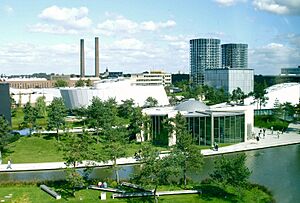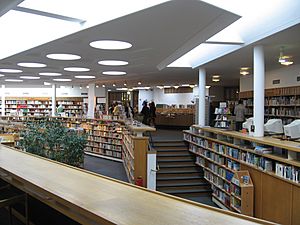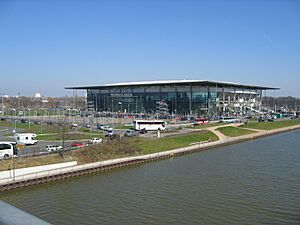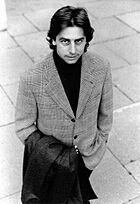Wolfsburg facts for kids
Quick facts for kids
Wolfsburg
Wulfsborg (Eastphalian)
|
|||
|---|---|---|---|

Skyline of Wolfsburg at dusk.
|
|||
|
|||
| Lua error in Module:Location_map at line 530: Unable to find the specified location map definition: "Module:Location map/data/Germany Niedersachsen" does not exist. | |||
| Country | Germany | ||
| State | Lower Saxony | ||
| District | Urban district | ||
| Subdivisions | 16 Ortschaften, 40 Stadtteile |
||
| Area | |||
| • Total | 204.02 km2 (78.77 sq mi) | ||
| Elevation | 63 m (207 ft) | ||
| Population
(2022-12-31)
|
|||
| • Total | 125,961 | ||
| • Density | 617.395/km2 (1,599.05/sq mi) | ||
| Time zone | UTC+01:00 (CET) | ||
| • Summer (DST) | UTC+02:00 (CEST) | ||
| Postal codes |
38400–38448
|
||
| Dialling codes | 05361, 05362, 05363, 05365, 05366, 05367, 05308 | ||
| Vehicle registration | WOB | ||
| Website | www.Wolfsburg.de | ||
Wolfsburg is a city in Germany, located in the state of Lower Saxony. It sits on the Aller River. The city is about 75 kilometers (47 miles) east of Hanover and 230 kilometers (143 miles) west of Berlin.
Wolfsburg is famous because it's home to Volkswagen AG, one of the world's biggest car companies. The main Volkswagen car factory is also here. Next to the factory is the Autostadt, a cool place where visitors can see cars from different brands like Audi, Bentley, and Porsche.
Wolfsburg is special because it's one of the few German cities built in the first half of the 1900s as a "planned city." This means it was designed from scratch. It started on July 1, 1938, as a "company town" for workers building the first Volkswagen cars. Back then, it was called Stadt des KdF-Wagens bei Fallersleben. After World War II, on May 25, 1945, the city was renamed Wolfsburg. By 1972, more than 100,000 people lived there.
Contents
Where is Wolfsburg located?
Wolfsburg is at the southern edge of the Aller River valley. It's also next to the Mittellandkanal, a big canal. The city shares borders with the districts of Gifhorn and Helmstedt.
What is the weather like in Wolfsburg?
Wolfsburg gets about 532 millimeters (21 inches) of rain each year. This is not a lot compared to other parts of Germany. July is usually the warmest month. April is the driest, while July and August are the wettest.
| Climate data for Wolfsburg (1991-2020) | |||||||||||||
|---|---|---|---|---|---|---|---|---|---|---|---|---|---|
| Month | Jan | Feb | Mar | Apr | May | Jun | Jul | Aug | Sep | Oct | Nov | Dec | Year |
| Daily mean °C (°F) | 1.7 (35.1) |
2.3 (36.1) |
5.3 (41.5) |
9.8 (49.6) |
14.0 (57.2) |
17.1 (62.8) |
19.1 (66.4) |
18.8 (65.8) |
14.6 (58.3) |
10.0 (50.0) |
5.6 (42.1) |
2.6 (36.7) |
10.1 (50.1) |
| Average precipitation mm (inches) | 50.2 (1.98) |
38.3 (1.51) |
40.7 (1.60) |
34.7 (1.37) |
50.8 (2.00) |
51.5 (2.03) |
67.0 (2.64) |
62.1 (2.44) |
49.5 (1.95) |
45.4 (1.79) |
45.0 (1.77) |
48.5 (1.91) |
583.7 (22.99) |
| Mean monthly sunshine hours | 48 | 70.6 | 120.5 | 183.7 | 217.8 | 222.4 | 223.1 | 207.7 | 154.8 | 109.1 | 49.6 | 37 | 1,644.3 |
| Source: Deutscher Wetterdienst | |||||||||||||
A brief history of Wolfsburg
The "Wolfsburg" Castle was first mentioned in 1302. It was the home of the noble Bartensleben family. The castle was originally a tower next to the Aller River. Later, it was protected by a moat.
In 1938, Wolfsburg was founded as a planned town. It was built to house workers for the new Volkswagen factories. These factories were making the first Volkswagen Beetle cars. During World War II, military vehicles and equipment were made here. Many forced workers and prisoners-of-war were made to work in the factories.
American troops captured the city and the Volkswagen factory on April 11, 1945. They freed about 7,700 forced workers. The city was renamed Wolfsburg on May 25, 1945, after the castle. The Americans left in June 1945, and the area became part of the British occupation zone. In 1951, Wolfsburg became its own urban district.
In 1955, the one-millionth VW Beetle was made in Wolfsburg. Even though Beetle production ended here in 1974, the factories in Wolfsburg are still very important for Volkswagen.
During the "German economic miracle" (a time of fast economic growth), many workers came to Wolfsburg, especially from Italy.
In 1972, Wolfsburg grew a lot when 20 nearby towns joined the city. Its population reached almost 131,000 people. The city's area also grew from 35 to nearly 204 square kilometers (79 square miles). In 1973, the population reached its highest point: 131,971.
In 1988, Wolfsburg became a university town. The University of Applied Science Braunschweig/Wolfenbüttel was established here. Today, it's called Ostfalia University of Applied Sciences.
In 2003, Wolfsburg briefly changed its name to "Golfsburg" to promote the new Volkswagen Golf car. This campaign got a lot of attention!
In 2009, the city's football team, VfL Wolfsburg, won the German football league. About 100,000 people celebrated in the city center.
Fun places to visit in Wolfsburg
Wolfsburg has a unique city center. Instead of an old medieval town, it has a modern attraction called the Autostadt. The older part of the city, Alt Wolfsburg (de), has some traditional manor buildings. The Wolfsburg Castle sits on a hill by the Aller River.
The Autostadt is an outdoor museum and theme park about cars. It's owned by Volkswagen. You can see pavilions for different car brands like Volkswagen, Audi, Lamborghini, and Porsche.
The Autostadt also has a planetarium, a fancy hotel, and the Phaeno Science Center. The Phaeno is Germany's largest hands-on science museum. There's also a water skiing resort and an art museum called Kunstmuseum Wolfsburg.
Another cool attraction is the Wolfsburg Water Show. It's the world's largest water-flame-laser-video fountain show. Its fountains can shoot up to 70 meters (230 feet) high! You can see it during special events at the Autostadt.
BadeLand is another popular place. It's a wellness and relaxation center with swimming areas and different saunas.
How many people live in Wolfsburg?
Wolfsburg's population grew quickly. In 1938, about 1,000 people lived here. By 1950, it was 25,000, and by 1958, it doubled to 50,000. In 1972, the population went over 100,000. This happened when several nearby villages joined the city. In 1973, the population reached its highest at 131,971. At the end of 2012, about 123,144 people lived in Wolfsburg.
Wolfsburg is home to people from many different countries. Here are some of the largest groups (as of 2018):
| Rank | Nationality | Population (31.12.2018) |
|---|---|---|
| 1 | 5,506 | |
| 2 | 1,469 | |
| 3 | 1,349 | |
| 4 | 682 | |
| 5 | 563 | |
| 6 | 521 | |
| 7 | 475 | |
| 8 | 450 | |
| 9 | 450 | |
| 10 | 403 | |
| 11 | 326 | |
| 12 | 310 | |
| 13 | 308 | |
| 14 | 261 | |
| 15 | 259 |
How Wolfsburg is organized
Wolfsburg is divided into 41 districts. These districts are grouped into 16 larger areas called "localities." Each locality has its own council and a local official who acts as its mayor.
The city's administrative area also includes six nature reserves. Five of these are in the old Aller River valley.
Buildings and art in Wolfsburg

Historical castles to explore
- The Schloss Wolfsburg (Wolfsburg Castle) is a 13th-century castle. It's the city's landmark because Wolfsburg is named after it.
- The Burg Neuhaus (Neuhaus Castle) is a medieval castle with a moat from the 14th century.
- The Schloss Fallersleben (Fallersleben Castle) was finished in 1551. Since 1991, it has been home to the Hoffmann-von-Fallersleben-Museum.
Museums to visit
- The Kunstmuseum Wolfsburg (Art Museum Wolfsburg) is known around the world. It shows modern and contemporary art.
- The Städtische Galerie (Municipal Gallery) is inside the Schloss Wolfsburg. It displays many different pieces of modern art.
- The AutoMuseum Volkswagen opened in 1985. It's in an old textile factory.
- The Stadtmuseum Wolfsburg (City Museum) is a modern museum. It tells the history of the castle, the region, and the city. It's located inside the Wolfsburg Castle.
- The Hoffmann-von-Fallersleben-Museum is in the castle of Fallersleben. It teaches about German poetry and democracy, focusing on the life of Hoffmann von Fallersleben.
- The Burg Neuhaus (Neuhaus Castle) has an exhibit of castle models, old weapons, and documents about life before 1800.
- The Autostadt is a very popular theme park in Europe. Its main topic is cars and how people get around.
- The Phæno is a science center with 250 hands-on experiments. It has a unique design by architect Zaha Hadid.
Buildings designed by Alvar Aalto
- Heilig Geist Kirche or Church of the Holy Spirit
- Stephanuskirche or the Church of St. Stephen
- Alvar-Aalto-Kulturhaus or Alvar Aalto Cultural Centre
Sports in Wolfsburg
Wolfsburg has a famous professional sports club called VfL Wolfsburg, started in 1945.
- The men's football team won the Bundesliga in 2009. They also won the DFB-Pokal (German Cup) in 2015 and the DFL-Supercup in 2015.
- The women's football team has been even more successful! They have won six Bundesliga titles and seven DFB-Pokal titles. They also won the UEFA Women's Champions League twice in a row, in 2013 and 2014.
Wolfsburg is also home to the ice hockey team Grizzlys Wolfsburg. They have been one of the top teams in the Deutsche Eishockey Liga since 2007. They were runners-up in 2011, 2016, and 2017.
The city also hosts the Volkswagen Challenger tennis tournament every year since 1993.
Wolfsburg's sister cities
Wolfsburg has special connections with other cities around the world. These are called "twin towns" or "sister cities."
 Marignane, France (since 1963)
Marignane, France (since 1963) Province of Pesaro and Urbino, Italy (since 1975)
Province of Pesaro and Urbino, Italy (since 1975) Halberstadt, Germany (since 1989)
Halberstadt, Germany (since 1989) Tolyatti, Russia (since 1991)
Tolyatti, Russia (since 1991) Bielsko-Biała, Poland (since 1998)
Bielsko-Biała, Poland (since 1998) Jiading (Shanghai), China (since 2007)
Jiading (Shanghai), China (since 2007) Jendouba, Tunisia (since 2010)
Jendouba, Tunisia (since 2010)
Friendly cities
Wolfsburg also has friendly relationships with these cities:
 Popoli, Italy
Popoli, Italy Sarajevo, Bosnia and Herzegovina (since 1985)
Sarajevo, Bosnia and Herzegovina (since 1985) Changchun, China (since 2006)
Changchun, China (since 2006) Puebla, Mexico (since 2010)
Puebla, Mexico (since 2010) Toyohashi, Japan (since 2011)
Toyohashi, Japan (since 2011) Chattanooga, United States (since 2011)
Chattanooga, United States (since 2011) Dalian, China (since 2011)
Dalian, China (since 2011) Nanhai (Foshan), China (since 2015)
Nanhai (Foshan), China (since 2015)
Famous people from Wolfsburg

- August Heinrich Hoffmann von Fallersleben (1798–1874), a poet who wrote the German national anthem.
- Gabriele von Lutzau (born 1954), an artist and sculptor.
- Peter Bialobrzeski (born 1961), a photographer.
- Edward Berger (born 1970), a film director and screenwriter.
- Dero Goi (born 1970), a musician and lead singer of the band Oomph!
- Amanda Somerville (born 1979), an American singer-songwriter who lives in Wolfsburg.
- Anna-Katharina Samsel (born 1985), a figure skater, model, and actress who grew up here.
Sports stars from Wolfsburg
- Liane Winter (1942–2021), a marathon runner.
- Siegfried Reich (born 1959), a footballer who played many games.
- Petra Damm (born 1961), a footballer who played for the German women's national team.
- Eckhardt Schultz (born 1964), a rower who won a gold medal at the 1988 Summer Olympics.
- Michael Knauth (born 1965), a field hockey player who won a gold medal at the 1992 Summer Olympics.
- Sophie Scheder (born 1997), an artistic gymnast who won a bronze medal at the 2016 Summer Olympics.
See also
 In Spanish: Wolfsburgo para niños
In Spanish: Wolfsburgo para niños










